Dirt Bikes 101
Shock Basics, Maintenance, & Adjustment. - #3 in a series
| Basics The aged flatulent one wanted me to do this months column on suspension.
Well, Mike, it is a little more involved than that. We will split it up into two months.
This month, shocks and next month, forks. There is just too much info to try to squeeze it
all into one article. |
|
| This is a picture of a Gold Valve and the
stock shock piston. Notice the 3 large oblong holes in the Gold Valve. The shims are held tight against the face of the valve and oil is forced through the holes bending the shims off the face. This is where the damping occurs. This shows the compression side of the piston. The rebound side has much smaller holes on both the stock and aftermarket pistons. |
|
| Here is a shot of the shims in their
respective position ready to install on the shock shaft. The shims on the left are the compression shim stack and the shims on the right are the rebound shim stack. Okay, we know the shims bend off the face of the valve. The amount they bend controls the damping. This is controlled by a few variables, one of which is known as the clamping shim. This is the smallest shim at the ends of the shim stacks. This is what tightens everything together. This means only the edges of the shims bend. The outer diameter of the clamping shim determines how much of the other shims cannot bend. If more of each of the shims are allowed to bend, the valving feels softer. If we stack more of the same diameter shims together, this makes it harder to bend and makes it stiffer. Same thing if we use thicker shims. This will make it harder to bend and make it stiffer. Depending on which shims we use, we can alter the damping characteristics virtually any way we want. |
|
| Here is the stock piston with its shims
displayed. From upper left is the plate that the assembly tightens against, the compression stack beginning with its clamping shim, increasing in size , the piston itself and then the rebound stack ending with the end plate that the nut tightens against. |
|
| Here is the Gold Valve installed on the
shock shaft. The reservoir holds the bladder (or floating
piston in some shocks- Ohlins, for instance). This allows us to pressurize one side of the
bladder/piston to help keep the shock oil from cavitating (foaming). You can see how well
it works when you pull the shock apart and the oil foams up like a Coke after being
dropped. Altering the nitrogen pressure can affect compression damping also. Normal
pressures run from 140 psi up to 300+ psi. I usually use 175psi, except for XR shocks that
use 225 psi, when doing a revalve. Remote reservoirs function the same as an attached
reservoir except they obviously have a hose between them to allow a different mounting
position. |
|
| The rebound adjuster is nothing more than
a needle that is screwed into a fixed seat that controls a bleed passage around the
piston. The adjuster is a tapered screw that pushes the needle further into the shaft the farther the screw is screwed into the clevis. It is a little difficult to see, but here is a picture of the adjuster screw. This is looking down into the clevis with the shaft removed. |
|
| You can see the visible part of the adjuster on the right side of the clevis. The adjuster is the brass screw in the very center of the hole. | |
| The compression adjuster works a little
differently. As the shock moves through its travel, oil is displaced by the volume of the
shaft assembly and is forced into the reservoir. The compression adjuster controls the
rate at which the oil goes into the reservoir. This is also a needle and seat adjuster. Some shocks have ball type joints (a spherical joint) at the ends, some have needle bearings. Some of the spherical joints have a bushing surrounding the ball that do not require grease. Check your shop manual to see if they recommend lubrication. Needle bearings obviously need a good quality waterproof lube. I use the Bel-Ray grease. It's nice and thick. Good stuff.. Maintenance |
|
| Measure the spring installed length and
the adjuster settings and write them down. Loosen the spring preload adjuster until the
spring is loose. There are a couple different methods for holding the lower spring seat to
the shock. One is a circlip that is virtually hidden until the outer collar is pushed
towards the spring a little. It is common to have to tap it lightly to get it to move.
This should expose the circlip. Remove the circlip and the spring seat will slide over the
lower end of the shock. This KYB shock has a split collar that can be slid out sideways
once the preload adjuster is loosened far enough. |
|
| Okay, we have a shock without a spring on
it. Remove the schraeder valve cap and release the gas pressure. On most shocks, the valve
points straight down out of the reservoir. Using a socket to protect the valve stem, tap
the reservoir cap down far enough to expose the circlip. Use two small flat blade
screwdrivers to remove the circlip. It ca be a little difficult to explain, but push the
circlip down until it is out of its groove and use the other screwdriver to pull the
circlip over the tip of the first screwdriver. In the next picture, this circlip is the
one in the shock body itself, but the circlip and removal are the same. I've got the
circlip pushed down and I am ready to pull it up with another screwdriver. If you scratch
the surface much more than 1 or 2 mm below the circlip groove, you can create a leak due
to the seal not sealing correctly. Be careful. |
|
| Pull the reservoir bladder out of the
reservoir body. Normally I use a valve core removal tool screwed over the end of the valve
stem and pull up with that so nothing gets damaged. The bladder may be a little stubborn.
Wiggle it back and forth to remove it. Now to remove the guts of the shock. There is a cap on the end of the shock body that protects the seal head. This metal cap is pressed into the end of the body. Use a sharp chisel or punch and tap it up. Tap evenly from opposite sides to prevent it from getting wedged too tightly. We don't need to break any expensive parts. I use a clothes pin to hold the cap up out of the way. Now the seal head is exposed. Showa shocks have two circlips and another collar between the circlips. First thing you'll need to do is remove the one circlip that is visible. A pair of snap ring pliers can push the clip out of place enough to get your screwdriver tip under it and pull it off. Push the seal head down. On Showa shocks this will leave a washer resting on the lower circlip. Now you can remove this washer. Otherwise it can be a royal bitch trying to get it out with the seal head in position. With the washer removed, you'll be able to see the lower circlip. KYB owners won't have to deal with this first circlip and washer business. Just push the seal head down until the circlip is exposed (just like the above picture shows). Remove the circlip. Now you can pull the shaft assembly out. Normally wiggling it will be enough to remove it. Sometimes I've had to tap on the clevis end to get the shaft out. Be SURE you don't have it cocked off to one side. Remember, you're dealing with some really expensive stuff. Screw something up and you'll go from saving $50 to spending literally hundreds. |
|
| Here is the shaft assembly once we get it
out if the shock body. From left to right, the clevis end, the bottoming bumper, the cap, the seal head and the piston and shim assembly. If we were doing an oil change we could rinse everything off with brake cleaner and reassemble it. We'll get to that in just a minute. We'll finish pulling this one all the way apart in case you're replacing the seal or bushing or the bottoming bumper. |
|
| Actually the bottoming bumper can be
replaced without losing any oil (shock still fully assembled without the spring) by
removing the clevis end. This is relatively easy and painless. Once the nitrogen pressure
is released out of the reservoir, the clevis end can be taken off the shaft and the bumper
replaced. There is a locknut (normally a 22mm) that is right at the clevis end of the
shaft. You can use this to unscrew the shaft from the clevis end. The next picture shows
the locknut being loosened but without the rest of the shock. As long as the rebound
needle isn't removed, you won't lose any oil (provided all the pressure in the reservoir
is released). A little red Loc-Tite on the shaft threads and reassembling and you'll be
ready to go. It would be a good idea to mark the locknut position in relation to the
clevis end so you have a way of knowing when it is fully tightened . |
|
| Okay, back to removing the piston and seal
head. The nut that holds the piston on the end of the shaft is peened in place from the
factory. This peening needs to be ground/machined off so the nut can be removed without
damaging the end of the shaft. Some shocks have a check |
|
| valve assembly in the center of the shaft.
On these shocks, the peening also holds the check valve in place. It is critical that this
peening is removed very carefully. If you're unsure of whether your shock has this check
valve, grind the peening as though it does have one. We would rather be safe than sorry. Here is what the peening looks like before it is ground away. |
|
| What you want to accomplish is to remove enough of the peened area to facilitate the nut removal but leaving the center intact. This is what it looks like after I've removed enough take the nut off. | |
| Now you can loosen the nut. If it begins
to come off too hard, remove a little more along the sides of the peening. Once the nut is
removed, you can use a file to remove any burrs and a thread file to restore the threads.
If you try to use a tap, it can cut new threads if it doesn't start in the same place. Be
careful. Here's what it looks like when done correctly. |
|
| Now you can pull the piston off the end of
the shaft. A coat hanger cut and bent in a "U" shape can be useful in holding
the shim and piston assembly together. Here is what we have when the piston assembly is removed. Now
the seal head can be removed. |
|
| This is what the seal head looks like once
removed. The seal and bushing can be changed but it isn't much cheaper than replacing the seal head assembly. You can save maybe $20-25 by changing the individual parts. |
|
| The shock bumper can now be replaced if it
is needed. While we have the seal head off, it can help the bleeding if we drill a hole in
the side of the seal head. Showa shocks come with a hole from the factory. A 1/8"
hole halfway between the sealing o-ring and the bottom edge will work wonders. In the next
picture you can see the hole. Drill just deep enough to get through the wall of the seal
head. A shot of brake cleaner will rinse out any metal shavings. |
|
| Now reinstall the seal head. Make sure you
don't fold the dust seal under when installing it over the step of the shaft. If you're
installing an aftermarket piston, this is where it comes in. Be sure to have the larger
shims (compression stack) facing towards the clevis end. If you are changing anything in
the piston assembly (shims, piston, etc) you need to make sure the piston is spaced up so
the step (directly below the threads at the end of the shaft) is not exposed. What happens
is the nut will tighten down against this step instead of tightening down against the
shims and piston. |
|
| This is what it would look like if NOT spaced properly. The Gold Valve shim stack and piston is thinner than the original and needs to be spaced out. You can see the brass spacer installed in the above picture. The picture at left shows the step before the spacer and nut are installed. If a nut was installed without the spacer, it wouldn't tighten down properly. | |
| Be sure to use a new nut with red
Loc-Tite. Torque is normally 24 lb/ft. I torque it to 30 lb/ft because if this nut comes
loose, the results can be disastrous not only to the shock but to the rider also. Normally
the KYB thread is a 10x1.5 and the Showa is a 10x1.25. Don't guess, you need to be certain
of this. There is a fiber bushing that goes around the piston. If this is not in good condition (edge rolled or torn), now is the time to replace it. The aftermarket bushings are split and need to be held in position while the piston is inserted into the shock body. We're not quite ready for this though. Okay, we have the shaft assembly ready. We have the body thoroughly rinsed out with brake cleaner. The reservoir bladder is rinsed clean and is installed on the reservoir cap. Remember what Grandma said. "Cleanliness is next to Godliness". She must've been talking about shock servicing. We're ready to reassemble the shock. The method I use is different than some manufacturers use. I've found bleeding is much easier with this method and getting the proper amount of oil in the shock is more of a sure thing. Here we go. |
|
| Tighten the shock body in a vise with the openings pointing straight up. Place a drain pan directly under the vise on the floor. This will get messy. Pour new oil in the reservoir until it is almost half full. Insert the bladder into the reservoir. | |
| If the reservoir end cap has to be pointing a certain direction (like this YZ 125), now is the time to point it in that direction. Push the bladder into the reservoir until oil gushes out all over. Like this..... | |
| Push the bladder into the reservoir until the circlip groove is visible. Install the circlip and pull the end cap up into position seated against the circlip. Now you need to pressurize the bladder with 35-40 psi of air. This will force any air trapped in the compression adjuster out, into the shock body. Add oil into the body until it is about an inch from the top edge. This is what you should have.... | |
| Now put the business end of the shaft
assembly in the body. If you have a new piston bushing, you'll have to hold it in place
while you push it into the body. Push the guts into the body slowly. You should see a lot
of bubbles coming up through the oil. Don't push too hard because oil will come shooting
out the hole in the side of the shaft. I told you this would be messy. Now run the shaft
through its stroke a few times. Don't pull the shaft up so far it sucks air through the
hole in the side of the shaft. This will result in pulling more air in under the piston.
Watch closely. If it sucks air, you need to start all over with the bleeding. |
|
Once you
get it so no more air bubbles are coming out, pull the shaft up as far as you can before
sucking air. Take a rubber or plastic hammer and tap the clevis end of the shaft assembly.
You want to tap it hard but don't pound it. What this does is makes the oil force the
compression shims off their seat far enough to release any trapped air bubbles. Do this
until no bubbles come up. This step is important. Don't take it lightly. Give the oil a
few minutes for the very small bubbles to surface. Fill the body with oil to near the top
edge. It should look like this... |
|
Once you have the air bled
out from under the piston, we're ready to push the seal head in. Tilt the shock body to
one side just a little. Now pull the shaft assembly up as far as you can with the body
full of oil. You want to get as much oil in the body as you can. Turn the seal head so the
bleed hole is at the higher side of the tilted shock body. You want any air trapped under
the seal head to go to the high spot (where the bleed hole is). Push the seal head in
place. You should see bubbles coming through the bleed hole. |

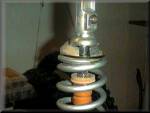
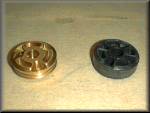
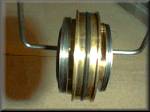
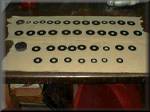
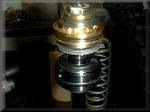
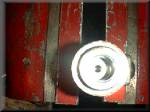
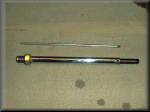
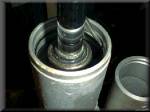
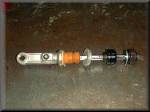
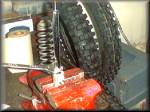
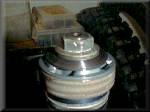
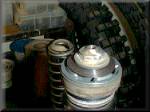
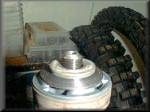
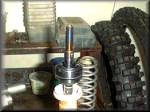
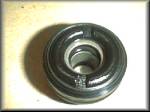
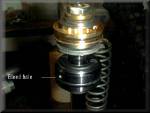
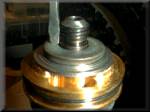
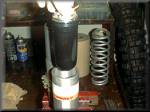
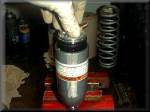
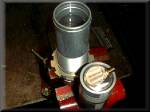
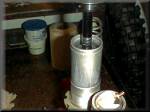

 Your Privacy Choices
Your Privacy Choices